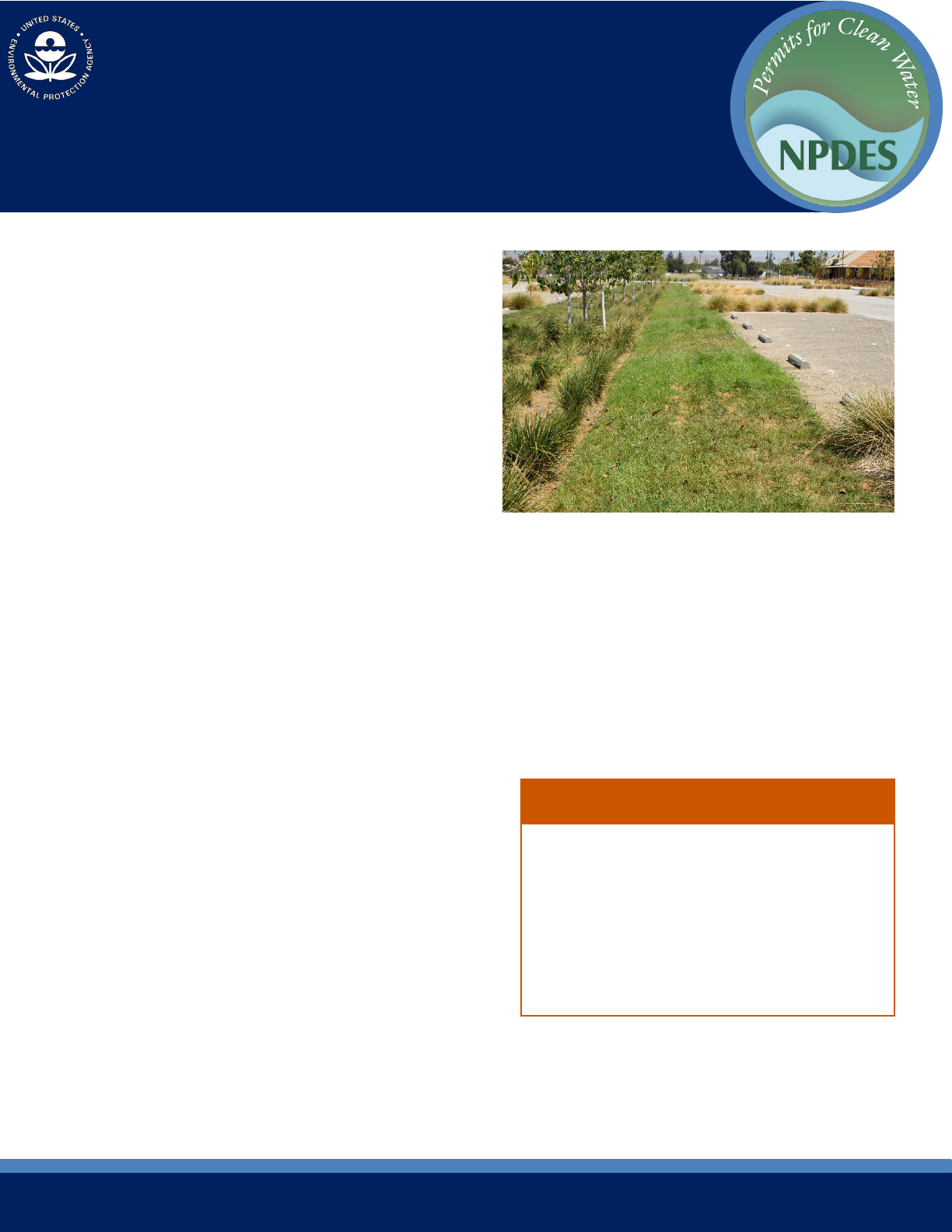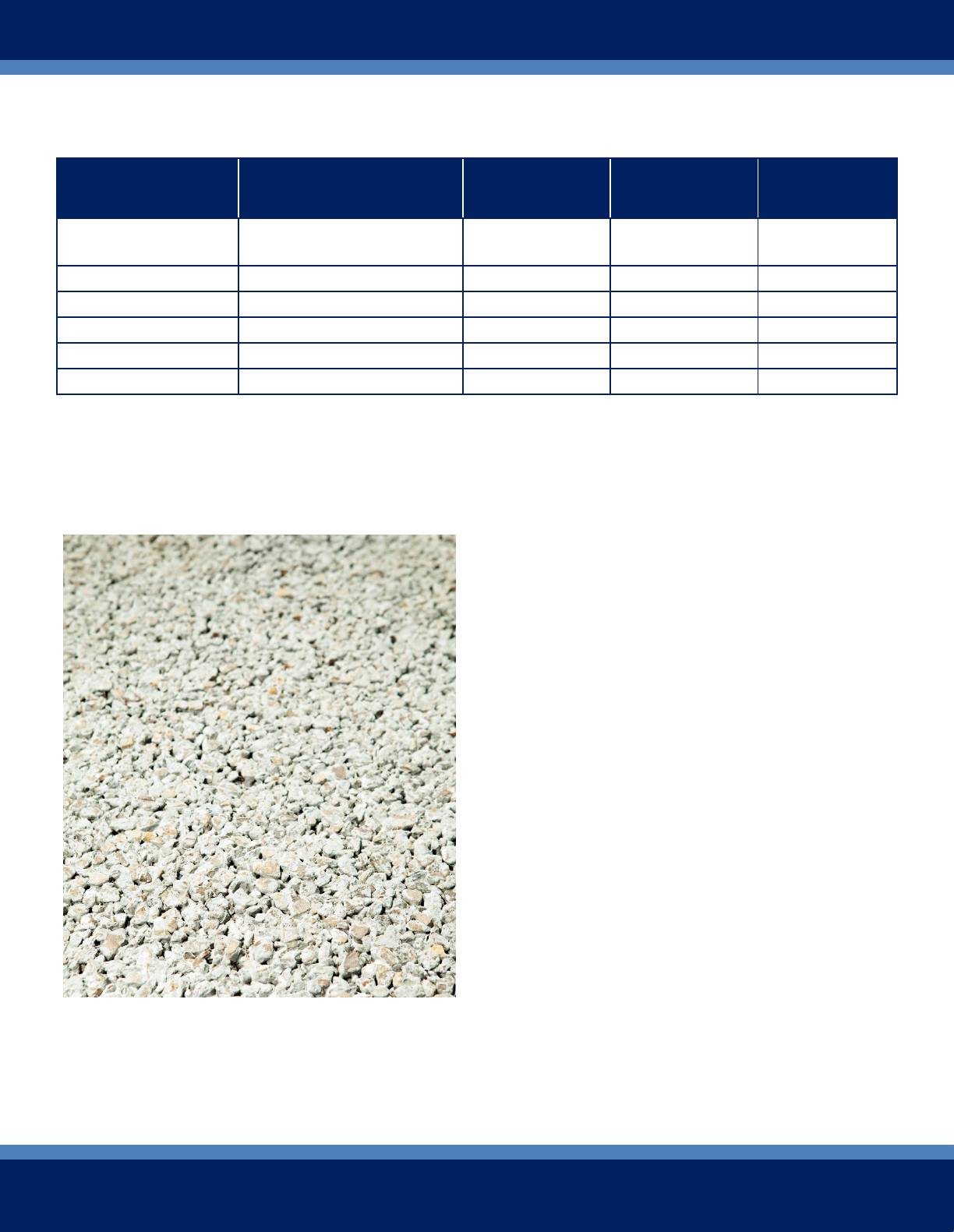
- - - -
-
Stormwater Best Management Practice
Green Parking
Minimum Measure: Post Construction Stormwater Management in New Development and
Redevelopment
Subcategory: Innovative BMPs for Site Plans
Description
“Green parking” refers to several techniques that,
together, reduce stormwater discharge from parking lots.
Green parking techniques include setting the maximum
number of parking spaces, right-sizing the dimensions of
parking spaces, substituting alternative surfaces for
asphalt in overflow parking areas, using green
infrastructure to treat stormwater, encouraging shared
parking and providing economic incentives for structured
parking.
Applicability
All green parking practices in the above description are
applicable to new developments, and some are
applicable to redevelopment projects, depending on site
characteristics. In urban areas, practices such as
encouraging shared parking and providing economic
incentives for structured parking are practical and often
necessary. Commercial areas can have excessively high
parking ratios (the number of spaces per building area),
providing an opportunity to convert impervious surfaces
with infrequent use to permeable surfaces.
Implementation
The most straightforward green parking strategy is to
right-size the number of parking spaces, ensuring that
there are enough spaces for the intended uses. Parking
lots typically have far more spaces than necessary. By
right-sizing parking, planners, developers and the
community can ensure that there is enough parking
without creating unnecessary impervious surface. The
problem of too much parking results from designing
parking ratios around the highest hourly parking needs
during peak seasons—a common practice in parking lot
design. Designing to average demand, as opposed to
the peak demand, results in fewer spaces and less
A parking lot designed with green infrastructure, vegetated
buffers, and alternative surfaces can improve the quality of
stormwater from the parking lot.
impervious space. For existing developments, design
engineers can reduce the number of parking spaces and
convert unused spaces to landscaped islands that
provide aesthetic benefits and reduce impervious area.
Table 1 provides examples of conventional parking
requirements and compares them to average parking
demand.
Resources
• Parking Spaces/Community Places: Finding the
B
alance through Smart Growth Solutions is
a
gui
debook about parking policies and incl
udes
ex
amples of how they can save money, improv
e
t
he environment and meet broader communit
y
goals.
• EPA’
s Mixed-Use Trip Generation Model ca
n
help local governments better estimate parking
dem
an
d.
https://www.epa.gov/npdes
EPA-832-F-21-031Q
December 2021

—
c
NPDES: Stormwater Best Management Practice—Green Parking
Table 1. Conventional minimum parking ratios.
Land Use Unit
ULI Standard
Parking Value
a
ITE Standard
Parking Value
b
Actual Parking
Demand
c
Apartment/
condominium
Spaces per dwelling unit 1.50–1.70 1.20–1.38 0.41–2.82
Retail
Spaces per 1,000 ft
2
GFA
3.60
2.65
0.36–3.0
Hotel
Spaces per room
1.00
0.64
0.31–15.35
Lounge
Spaces per 1,000 ft
2
GFA
10.00
13.30
3.93–8.38
Office
Spaces per 1,000 ft
2
GFA
3.8
2.84
0.56–2.88
Restaurant
Spaces per 1,000 ft
2
GFA
10.50
10.10
2.05–14.75
Source: Kimley-Horn, 2016
GFA = Gross floor area of a building without storage or utility spaces.
a
Standard rate from Urban Land Institute (ULI) as cited in Kimley-Horn, 2016.
b
Standard rate from Institute of Transportation Engineers (ITE) as cited in Kimley-Horn, 2016.
Range of rates for 12 municipalities studied in Kimley-Horn, 2016.
Minimizing the length and width of individual parking
spaces is another technique that can minimize
impervious area. Planners often cite large sport utility
vehicles as barriers to minimization techniques. One
option to address this problem is to provide a mix of
parking space sizes and designate smaller spaces for
compact cars. New technologies also allow for the use of
intelligent parking reservation systems that can assign a
driver to a parking space according to their vehicle size
(Caicedo et al., 2012).
Another effective green parking technique is the use of
alternative surfaces. Alternative surfaces include
permeable surfaces and reduce stormwater discharges
by increasing infiltration. They can include gravel,
cobbles, wood mulch, brick, grass pavers, turf blocks,
natural stone and permeable pavements. Permeable
pavements include permeable pavers, pervious concrete
and porous asphalt and can be effective substitutes for
conventional asphalt and concrete, given their durability.
For more information on permeable pavements, refer to
the Permeable Pavements fact sheet.
Green infrastructure practices such as bioretention
practices and grassed swales are other green parking
techniques that can effectively treat stormwater before it
leaves a parking lot.
Using permeable concrete instead of asphalt can reduce
stormwater quantity and improve water quality.
Page 2
Office of Water, 4203M

—
NPDES: Stormwater Best Management Practice—Green Parking
Bioretention practices are shallow, landscaped
ar
eas that temporarily store stormwater. Stor
ed
wat
er then filters down through the bed of t
he
s
ystem, where it either infiltrates into the subsurfac
e
s
oils or is collected by an underdrain pipe f
or
dis
charge into a storm sewer system or anot
her
stormwater facility. For redevelopment projects,
des
ign engineers can convert underutilized park
ing
s
paces to bioretention practice
s.
Grassed swales are vegetated conveyances that
s
low stormwater flow, allowing solids to sett
le.
Dependin
g on site conditions and design type
,
gr
assed swales can also promote infiltrat
ion.
Des
ign engineers can integrate both bioretention and
grassed swale stormwater controls into parking lot
landscaped areas and maintain them along with other
landscaped areas.
In mixed-use areas, shared and structured parking can
reduce the conversion of land to impervious cover.
A shared parking arrangement involves two parties
t
hat share one lot. For example, an office t
hat
ex
periences peak demand during weekdays c
an
s
hare its parking lot with an adjacent church t
hat
ex
periences peak demand during weekends
and
ev
enings
.
Structured parking, such as above- or below-ground
par
king garages, can greatly reduce the amount
of
s
tormwater-generating area for a given park
ing
demand.
Limitations
Limitations to green parking techniques include
applicability, cost and maintenance. For example,
shared parking is practical only in mixed-use areas, and
the cost of land versus the cost of construction may limit
structured parking.
The cost of individual green infrastructure practices may
also be prohibitive in some cases. Permeable
pavements, bioretention practices and grassed swales
can be more costly than traditional development—
though it is important to take into account the cost
savings that can be achieved by reduced stormwater
management requirements.
The pressure to provide an excessive number of parking
spaces can result from the fear of customer complaints
about limited parking. These factors can pressure
developers into constructing more parking than is
necessary. Together, these barriers inhibit the
construction of parking lots using the maximum number
of green parking techniques.
Effectiveness
In most cases, design engineers can use multiple
practices together, increasing overall effectiveness.
Depending on the combination of strategies designers
implement, green parking can reduce the amount of
impervious surface, reduce stormwater flow rates and
volumes, reduce stormwater pollutant concentrations,
and provide a range of other environmental benefits.
Heifer International’s parking lot is an example of the
benefits of rethinking parking lot design (Industrial
Economics, Inc., 2007). This nonprofit sustainable
community development organization in Little Rock,
Arkansas, designed an environmentally friendly parking
lot for its new headquarters. The lot features green
parking techniques including permeable pavement for
parking spaces and five bioswales to convey water to a
detention pond and treatment wetland next to the site.
The company also provided on-site bike racks and
dedicated parking spaces for carpooling and hybrid
vehicles. Water quality benefits include significant
reductions in stormwater volume and pollutants,
including nitrogen, phosphorus, suspended solids and
several heavy metals.
Cost Considerations
While some green parking materials have higher
construction costs than conventional development
materials, implementing green parking techniques can
lead to lower maintenance and stormwater management
costs. For example, in Bellingham, Washington, Bloedel
Donovan Park retrofitted part of its parking lot to add a
550-square-foot bioretention practice. In addition to
of
fer
ing
Page 3
Office of Water, 4203M

—
NPDES: Stormwater Best Management Practice—Green Parking
an aesthetic benefit by adding native plants to the
parking area, the bioretention practice reduced
impervious cover in the parking lot and saved 75 to 80
percent over conventional stormwater management
costs (LaCroix et al., 2004). Limiting the number of
parking spaces, minimizing parking space dimensions
and encouraging shared parking can also reduce
construction costs.
Specific costs associated with individual
stormwater controls can be found in the following
fact sheets:
Permeable Pavements
Bioretention Practices
Grassed Swales
Additional Information
Additional information on related practices and the Phase II MS4 program can be found at
EPA’s National Menu of Best Management Practices (BMPs) for Stormwater website
References
Center for Watershed Protection. (1998). Better site design: A handbook for changing development rules in your
community.
Caicedo, F., Blazquez, C., & Miranda, P. (2012). Prediction of parking space availability in real time. Expert Systems with
Applications 39(8), 7281–7290.
Industrial Economics, Inc. (2007). Green parking lot case study: Heifer International, Inc.
Kimley-Horn. (2016). Parking generation—Replacing flawed standards with the custom realities of Park+. Kimley-Horn
and Associates, Inc.
LaCroix, R., Reilly, B., Monjure, J., & Spens, K. (2004). A case study of the City of Bellingham’s use of rain gardens to
manage stormwater. Puget Sound Action Team.
Disclaimer
This fact sheet is intended to be used for informational purposes only. These examples and references are not intended to be
comprehensive and do not preclude the use of other technically sound practices. State or local requirements may apply.
Page 4
Office of Water, 4203M
